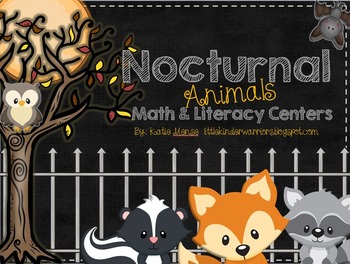Nocturnal Animals Math and Literacy Centers for Kindergarten
Katie Mense
11.7k Followers
Grade Levels
K
Subjects
Resource Type
Standards
CCSSK.CC.A.2
CCSSK.CC.A.3
CCSSK.CC.B.4
CCSSK.CC.B.4c
CCSSK.CC.B.5
Formats Included
- PDF
Pages
82 pages
Katie Mense
11.7k Followers
Also included in
- Thank you so much for viewing my October Centers Bundle! There are 4 themes included in this bundle. Each theme includes 4 Math and 4 Literacy centers. That makes 32 centers! The activities included in this packet are all aligned to the common core standards. They are interactive, hands-on, engagingPrice $28.00Original Price $32.00Save $4.00
Description
This unit includes a total of 8 math and literacy centers that can be used to supplement your Nocturnal Animal unit. The activities in this pack are common core aligned. There are also "I can" statement cards so that students can figure out how to do each task in the center on their own. For most of the activities, there are options on how to differentiate the center to meet all of your learners' needs.
Please see preview!
**All centers now include ANSWER KEYS as well!
The skills that are covered in this pack are: Counting, greater than, shapes, patterning, counting on, ten frames, sentence structure, sight words, color words, sequencing alphabet, capital and lowercase letters, rhyming, beginning sounds and cvc words.
Thanks so much!!
Katie Mense
littlekinderwarriors.com
Please see preview!
**All centers now include ANSWER KEYS as well!
The skills that are covered in this pack are: Counting, greater than, shapes, patterning, counting on, ten frames, sentence structure, sight words, color words, sequencing alphabet, capital and lowercase letters, rhyming, beginning sounds and cvc words.
Thanks so much!!
Katie Mense
littlekinderwarriors.com
Total Pages
82 pages
Answer Key
N/A
Teaching Duration
N/A
Report this resource to TPT
Reported resources will be reviewed by our team. Report this resource to let us know if this resource violates TPT’s content guidelines.
Standards
to see state-specific standards (only available in the US).
CCSSK.CC.A.2
Count forward beginning from a given number within the known sequence (instead of having to begin at 1).
CCSSK.CC.A.3
Write numbers from 0 to 20. Represent a number of objects with a written numeral 0-20 (with 0 representing a count of no objects).
CCSSK.CC.B.4
Understand the relationship between numbers and quantities; connect counting to cardinality.
CCSSK.CC.B.4c
Understand that each successive number name refers to a quantity that is one larger.
CCSSK.CC.B.5
Count to answer “how many?” questions about as many as 20 things arranged in a line, a rectangular array, or a circle, or as many as 10 things in a scattered configuration; given a number from 1-20, count out that many objects.






